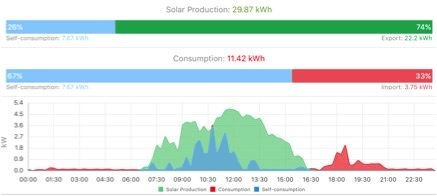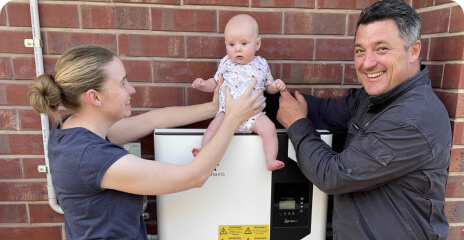So you have made the call to go solar, but what size should your system be? While small is smart was the conventional wisdom a few years ago, there is a growing school of thought that bigger is better. It is not just a fad either – as covered in this post, many of the reasons behind this trend are only going to grow more powerful over time.
By Jonathan Prendergast on May 11, 2017
Reposted with permission from https://onestepoffthegrid.com.au/go-big-six-reasons-rooftop-solar-champion/Recently we got solar. After 15 years of inner city living, we finally were in the ‘burbs, with a detached house and nice roof to put some panels.From the start, I wanted to get a big system: 8 kW, 10kW, or even bigger. Luckily for me, my more economically rational partner pushed me to justify the investment in such a large system. My day job often sees me trying to find unseen levers or unthought of value streams to justify innovative investments, so the challenge was set.As it turned out, there are many great reasons to maximise your rooftop potential by investing in a system that is larger than your immediate needs.
Adding more later is expensive and troublesome
I have met many people in my research who have solar, and have added or want to add more capacity. I still have not met one person that said they installed to much solar.
Technologies and standards change over time. If extending an existing solar system with more panels, you may need a completely new inverter. Your existing system may not meet current day standards, posing a challenge to the installer when getting sign off. Solar companies and installers are much more comfortable doing standard practice of installing new systems. Retrofit upgrades can be more trouble than their worth for them.
It’s a great time to get solar now
Prices for rooftop solar fell dramatically until 2011 due to technology and scale, and since then it has been more incremental through volume and competition. It’s a great time to buy.Rooftop solar systems in Australia still get ‘Small Technology Certificates’ (STCs) as part of the Renewable Energy Target. Installations today get 14 years’ worth of STCs up front, and this declines each year by 1 year. And the spot price of STCs is still high. It is also becoming more challenging to get larger solar systems, as network companies deal with some areas that generate more solar at midday than they use.Conditions may not stay this good for long, so it is best invest in your future system now.
The economies of scale are magnified
You are paying for an installer to work at your house for the day, and a solar sales consultant to arrange your system. You may as well get a few extra panels. Their costs aren’t affeted by the size of your system in a linear way.
STC rebates do rise in a linear fashion. To the point that the marginal cost of the system may be offset fully by increased STCs. This means in some circumstances the extra capacity may be fully offset by STCs!
Think of your future electric house
Will you get an electric vehicle one day? Or maybe a battery. It is quite likely that your house will use more electricity in the future, even for heating hot water, heating your house or cooking.
It may be more cost effective to get your future system now, rather than designing for current needs and then extending in the future.
You may have abundant solar energy at some times, but that’s kinda the point
We ended up getting a 7.8kW system with panels installed on east, west and north facing parts of the roof, and 7 flat mounted on our extension. We generally use 12kWh per day, and on average our system will produce 30kWh per day. Look at our profile below:

This sees us have an abundant supply of solar generation for our house, particularly in sunny months and on sunny days.
It also means on cloudy days and in winter, with less solar generation, we still have enough to serve our needs or offset our use. And this is what our future energy system will look like. Enough to meet our needs most of the year, with some back up, but also times of abundant energy. And that’s OK.
As new innovative business models and technologies are developed (like batteries) to make the most of times of abundance.
So many more reasons
It was great going through this justification process to see how many great reasons there are to get a really big solar system for your house. The politics of renewable has been very challenging, as new entrants (renewables) try to get market share against established goliaths. We are lucky that motivated households now have access to technology to take action themselves.
Feed-in-Tariffs for spill electricity from household solar range from 6-12 c/kWh. Conditions are improving, with a new legislated minimum rate of 11.3 c/kWh coming in Victoria, and a higher rate range recommended in NSW. These are actually pretty decent returns on investment. I wonder if anyone has done the maths?
And remember, there are many people who rent or are in apartments that can’t get solar. It really isn’t easy for others. Particularly business looking at solar or developers trying to build solar farms. Getting solar for our house took a couple of months, whereas solar in commercial world can take years to develop.
You can do your bit for everyone. If you are environmentally minded, investing the extra cash in more panels may make more sense than spending it on a battery. You can produce more clean energy rather than move a smaller amount of electricity to another part of the day.
It was amazing how all the solar companies have been trained to responsibly advise that for our small use and our night-time use profile, we should only get a small system. They all tried to talk me down!
Now, my only regret is we didn’t get more!
Jonathan’s Profile:Email for login:jonathan@prendergastprojects.com.auPhone for login: 0403 602 426 About Jonathan:Jonathan Prendergast is a director of Prendergast Projects, a Clean Energy and Energy Masterplanning company that specialises in project development and delivery services in sustainable infrastructure and urban regeneration projects.
Profile Picture:





